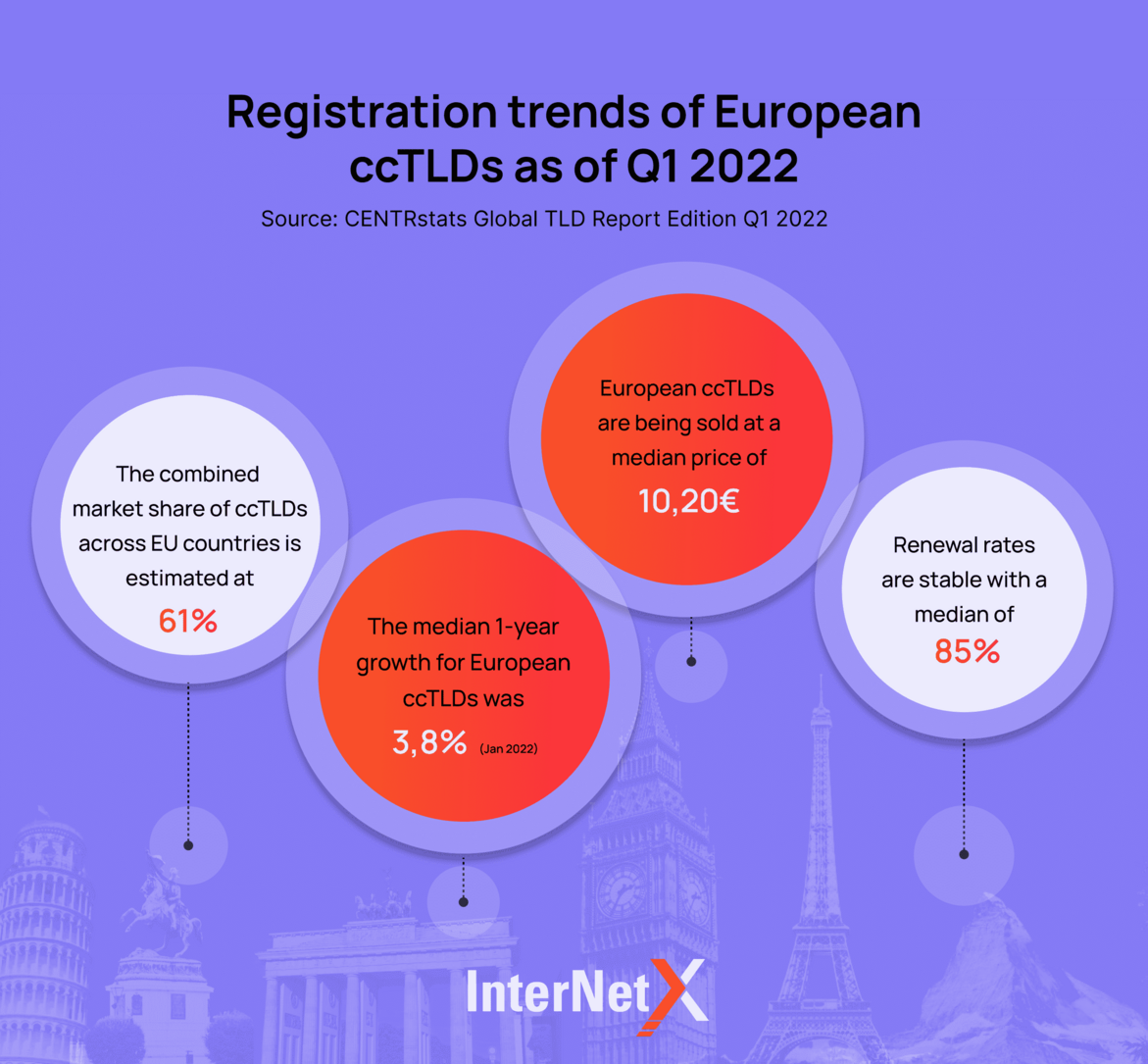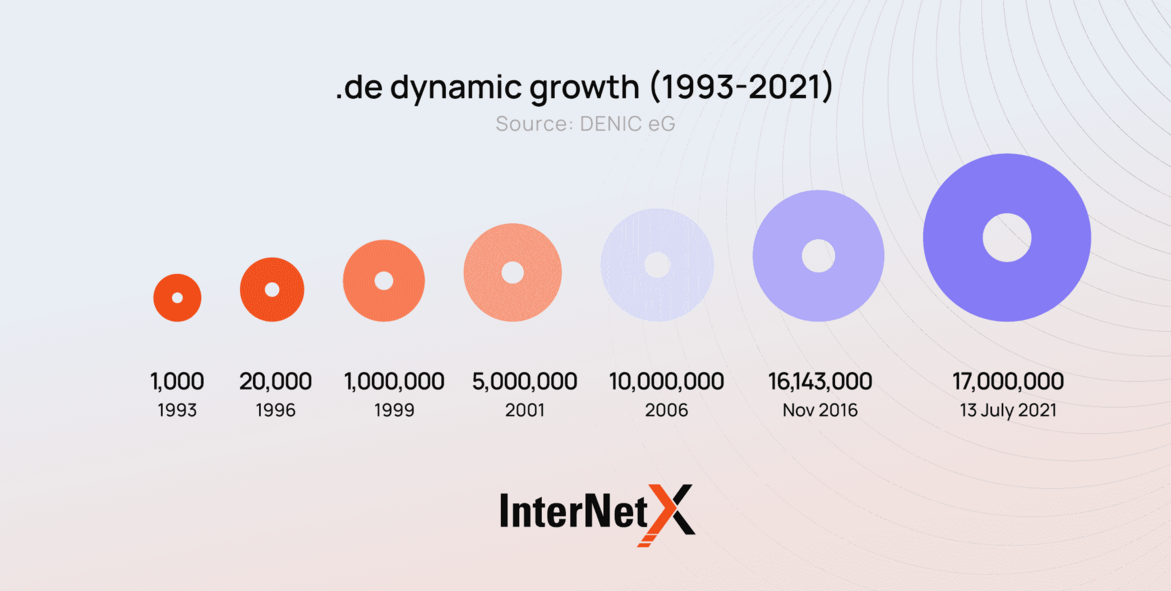
ccTLDs | The top 10 in Europe in 2022

Europeans remain loyal to their national ccTLDs! Find out which European ccTLDs have the largest number of registrations.
Published by

Carina Prüll
Date
Country codes are not always self-evident
In 1985, based on the ISO 3166-1 alpha-2 codes, the Internet Assigned Numbers Authority (IANA) assigned the ccTLDs in the Domain Name System (DNS) to represent states, countries and sovereign territories. This model has not always been linear. For example, although the alpha-2 code for the United Kingdom is GB, British internet users were already utilizing .uk as their official ccTLD. The ccTLD .gb is still reserved for the United Kingdom today, but registrations are currently not possible. Can you guess why .ua was assigned to Ukraine?
Country codes are not always self-evident when looking at the English name of a country. In this case, .ua comes from the first and last letters of the Ukrainian country name: Україна (Ukraïna). Many other ccTLDs are based on the native language, such as .de for Deutschland, Germany, .es for España, Spain, or .ch for Confoederatio Helvetica (Helvetic Confederation), Switzerland.
The European ccTLD market in 2022
ccTLDs play a very important role on the European domain market. Even in 2022, the figures speak for themselves. About 61% of the market share in European countries comes from ccTLD registrations.

Data from the CENTRstats Global TLD Report Q1 2022 shows that European registrants are slowly emerging from the shadows after the pandemic in 2022.
Although new purchases, deletions and registrar transfers are tapering off after the peak in early 2021, demand for new domains outpaces deletes. This balances the metrics and keeps growth rates positive, with a median 1-year growth of 3.8% and an 83.5% renewal rate. Still, European ccTLDs have not increased their market share over the past few years. Are gTLDs slowly gaining ground?
CENTR promotes and participates in developing European ccTLDs and collaborates with them to reach high standards. We met Barbara Povše, Chairwoman of CENTR’s Board of Directors and Head of .si Registry.
Fun fact
How much does a ccTLD cost? The current median ccTLD price is €10.20, which is slightly lower than last year’s median price of €10.90.
These are the ten most registered ccTLDs in Europe
Despite almost unlimited naming possibilities, Europeans remain extremely loyal to their national ccTLDs! Users and businesses perceive them as a valid seal of trust and commitment to safety and security. Furthermore, domain name holders feel more protected in case of abuse or disputes. ccTLD registries generally place an increased focus on tackling abuse and illegal online content and counterattacking DNS abuse.
We have compiled different data sets about domains in our Global Domain Report 2022. Turning to the respective registries for the most accurate data about ccTLDs in Europe, we were able to draw and present exciting results. Here we want to show you the 10 European ccTLDs with the most registrations in 2022. Check them out!
10. .be
1.74 million domain registrations
The Belgian ccTLD became active in 1989 and, as was often the case back then, the management was assigned to an individual. Pierre Verbaeten of the Katholieke Universiteit Leuven was the responsible person. The exponential growth of the internet and the increased demand for domain names necessitated a review of the Network Information Centers’ (NICs) operations. In 2000, the non-profit organization DNS Belgium took over the registry operations. At the end of 2005, the registry launched a three-month campaign offering free registration. The project was particularly successful, with over 17,000 registrations flooding in on the first day. The ccTLD has been used as the official logo for the Belgian federal government since 2003.
9. .es
1.99 million domain registrations
.es is very popular in Spain, where it was introduced on 14 April 1988. The ccTLD .es was granted by ICANN in 1988 and managed by RedIRIS in the early years. The public business entity Red.es took over the reins. The registry is connected to the Ministry of Industry, Tourism and Trade through the Secretary of State for Telecommunications and the Information Society. The rules for granting .es domains have undergone several changes throughout its history. With the liberalization of requirements and reductions of prices for domain registration between 2004-2005, the number of domains under .es tripled in a single year. The Spanish domain extension .es is one of the leading European ccTLDs today.
8. .ch
2.48 million domain registrations
The Swiss ccTLD comes from the Latin name of the country, Confoederatio Helvetica (Helvetic Confederation). This neutral variant was specifically chosen so as not to favor one of the four official languages. It has been available since 1987 and SWITCH Information Technology Services is the Registry operator, a Swiss foundation managing .ch but also .li for Liechtenstein. The most significant portion of foreign registrations come from Germany. Lately, interest in .ch domain registration from Chinese domain investors has grown strongly. Many companies worldwide have also taken advantage of the still relatively flexible availability of .ch to register catchy and memorable domains and create clever domain hacks.
7. .pl
2.54 million domain registrations
After the mitigation of the CoCom embargo on technological collaboration with post-communist countries, Poland received its ccTLD .pl on 30 July 1990. It is managed by NASK (Naukowa i Akademicka Sieć Komputerowa, Research and Academic Computer Network), the Polish research and development organization. At the end of March 2022, 35.38% of the .pl registrations came from natural persons while 64.62% from organizations. In Q1 2022, 90,76% of the .pl domain names in the DNS zone came from registrants in Poland.
6. .it
3.45 million domain registrations
On 23 December 1987, IANA assigned .it to an institute of the CNR (National Research Council) in Pisa, which registered the first .it domain name: cnuce.cnr.it. Over the years, registry operations have been in the hands of several institutes within the Pisa CNR. From 2001 onwards, the registry activities were gradually incorporated into the single registry operatorRegistro.it, which has been responsible for operations since 2009. The registry operates in close liaison with the relevant governmental bodies, primarily the Ministry of Economic Development.
Find perfect domains
5. .eu
3.75 million domain registrations
Although the European Union is not a country, it was assigned an ISO 3166 country code after more than five years of negotiations between the EU Commission and ICANN. The ccTLD entered the internet root zone on 2 May 2005 and was finally launched on 7 December 2005. Since 2014, it is available not only within the EU but to every person, business or organization in the European Economic Area. The ccTLD. eu also became available with the IDN .ею in Cyrillic letters on June 2016 and .ευ in Greek in November 2019. EURid manages the registry operations. The registry was created as a consortium of two European ccTLD operators, DNS Belgium (.be) and IIT-CNR (.it), based on the European Parliament and Council regulation (Regulation (EC) No. 733/2002). Today, .eu is an active member of the domain industry, reaching the Top 10 of European ccTLDs with the most registrations in 2022.
4. .fr
3.84 million domain registrations
The French ccTLD was introduced on 2 September 1986. It is run by AFNIC (Association française pour le nommage Internet en coopération, French Association for Cooperative Internet Naming), a non-profit corporation created in December 1997 to operate .fr and other French-owned TLDs like .re for Réunion Island or .paris. All European Union or EFTA residents are eligible to register a domain under .fr. On 1 July 2022, AFNIC started its new cooperation agreement to run the French ccTLD for five more years.
3. .nl
6.25 million domain registrations
Rank three of Europe’s most registered ccTLDs in 2022 is held by the relatively small country of the Netherlands. Its story began when Piet Beertema, system manager at the National Research Institute for Mathematics and Computer Science (CWI), asked the internet pioneer Jon Postel for a top-level domain for his country. The request was granted and .nl entered the namespace in the late ’80s. On 1 May 1986, the CWI registered the first .nl domain name cwi.nl, making the Dutch domain extension the first active ccTLD outside the United States.
Since 31 January 1996, the Dutch ccTLD has been operated by SIDN (Stichting Internet Domeinregistratie Nederland, Foundation for Internet Domain Registration Netherlands), based in Arnhem. Since 2003, anyone in the country or abroad can register a domain name under .nl, whether for business or private purposes. This new policy helped boost registrations, which reached 1 million in the same year. Today, .nl is among the largest ccTLD worldwide and is in the top 3 of our European ccTLD chart.
2. .uk
9.71 million domain registrations
The United Kingdom received its ccTLD .uk on 24 July 1985. Although its ISO 3166 country code is GB, the UK academic network Name Registration Scheme, JANET NRS, had already defined the two letters UK as the British top-level domain. Nonetheless, .gb was still reserved for the United Kingdom, although it was never used for general domain registration. At first, the ccTLD .uk was managed by single part-time volunteers, mostly from academia. The situation changed with the boost of the internet in the ’90s and the growth of domain name registrations. Automated registration services and a more entrepreneurial approach were needed. On 14 May 1996, the not-for-profit company Nominet UK was founded as the registry operator for .uk. The registry is a not-for-profit company limited by guarantee.
1. .de
17.2 million domain registrations
The German domain extension .de is undisputedly the ccTLD with the most registrations in Europe. With more than 17 million registrations, it also ranks among the Top 3 most registered extensions worldwide, after .com and the .tk.
.de was one of the first ccTLD on the internet. Based on the first two letters of the country in its native language, Deutschland, IANA added the ccTLD .de to the DNS root zone on 5 November 1986. For the first ten years, the Department of Computer Science of the University of Dortmund managed .de before passing on the baton to the University of Karlsruhe in 1994. The administration changed again in 1996 with the founding of DENIC eG, which took over the helm of the .de registry. Since then, .de has enjoyed impressively dynamic growth!

In the first three years, between 1996 and 1999, registrations skyrocketed from 20,000 to one million. By 2001, the number of domain names under .de was up to 5 million and doubled to 10 million by 2006. These boom years recorded a growth rate of over 100%! Around 34 years later, .de reached the milestone of 17 million domain registrations in July 2021.
The status quo of the domain industry in 2022
While the global economy faced the challenges caused by the pandemic, the domain industry continued to expand thanks to the ongoing push toward digitalization, chasing trends and following the market and developments in our society. In 2021, 13 new gTLDs reached General Availability (GA) and the ecosystem is working to promote the Universal Acceptance of a more digitally inclusive internet that provides the gateway to the next billion users.
These are clear signs of how vibrant, active and future-oriented this industry is. Discover exciting insights about recent developments and what’s in store for the domain industry in our Global Domain Report 2022. Furthermore, in our focus topic, “Crypto & NFT”, you can learn how these trends have impacted the domain market and read what featured industry experts have to say about the current and future development of the domain industry.






